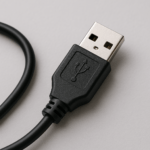
What Is USB 2.0? Understanding Its Impact, Features, and Evolution
2025-03-28
How to Find the Right USB Cable? A Comprehensive Guide
2025-04-10Your phone is your lifeline—until it dies. With countless types of phone chargers flooding the market, picking the right one isn’t just about convenience—it’s survival. That ancient Micro-USB cable? Probably obsolete. That sleek USB-C brick? Not always a universal fix. Between tangled wires, cryptic wattage labels, and Apple’s Lightning vs. USB-C drama, charging has become a modern-day puzzle.
This guide untangles the chaos. Whether you’re salvaging old gadgets or embracing cutting-edge tech, we’ll break down which charger works, why it matters, and how to dodge compatibility headaches. Stay powered.
USB Type-A Charger
The USB Type-A charger is the granddaddy of connectors—a rectangular port that’s been around since the mid-’90s. You’ve likely seen it on wall adapters, laptops, and car chargers. While not as flashy as newer models, its widespread compatibility keeps it relevant.
Pros:
- Universally compatible with older devices (think keyboards, power banks, and budget phones).
- Often paired with newer cables (e.g., USB-A to USB-C).
Cons:
- Non-reversible design (we’ve all flipped it three times before plugging in).
- Limited power delivery (typically 5V/2.5A, slower for modern devices).
USB Type-B Charger
USB Type-B is the niche player in the charger world. Its square shape with beveled corners was once common in printers, scanners, and older external hard drives. Today, it’s rare in phones but lingers in specialty electronics.
Pros:
- Durable design for stationary devices.
- High-speed data transfer in its heyday.
Cons:
- Bulky and largely obsolete for mobile devices.
Fun fact: The Type-B’s decline began when slimmer connectors like Micro-USB took over. You’ll still spot it in audio interfaces or industrial equipment.
USB Type-C Charger
The USB Type-C Cable has revolutionized charging and connectivity since its debut in 2014. With its symmetrical, oval-shaped design, this versatile cable eliminates the frustration of flipping connectors—plug it in any orientation, and you’re good to go. Beyond charging, the USB Type-C Cable handles data transfer, video output, and even peripheral connectivity, making it a true all-in-one solution.

Pros:
- Universal compatibility: The USB Type-C Cable works with smartphones, laptops (like MacBooks), tablets, and gaming consoles.
- Power Delivery (PD): Supports up to 240W charging, enabling rapid juicing for phones and power-hungry devices like gaming laptops.
- Future-proof: Mandated by the EU for all small electronics by 2024, ensuring long-term relevance.
Cons:
- Confusing standards: Not all USB Type-C Cables are equal—some lack PD or high-speed data support.
- Cost: Quality cables with full functionality (e.g., Thunderbolt 4) cost more than basic versions.
Did you know? A 2023 study by Statista found that 82% of new Android phones now ship with a USB Type-C Cable, including flagships like the Google Pixel 8 and Samsung Galaxy S24. Even Apple’s iPhone 15 series adopted USB-C, marking the end of its Lightning era.
For optimal performance, pair your USB Type-C Cable with a PD-compatible adapter. Pro tip: Look for cables stamped with “USB-IF Certified” to avoid knockoffs.
Mini-USB Charger
Mini-USB had a brief moment in the early 2000s, powering early digital cameras and MP3 players. Its compact size was revolutionary then but proved fragile.
Pros:
- Smaller than Type-A/B at the time.
Cons:
- Prone to port damage from frequent plugging.
- Phased out by sturdier Micro-USB.
Micro-USB Charger
The USB Micro Cable—often called Micro-USB—was the backbone of Android devices and budget electronics for over a decade. Introduced in 2007, this compact, T-shaped connector became the go-to for smartphones, Bluetooth speakers, and even some smart home gadgets. While USB-C now dominates, the humble USB Micro Cable still powers millions of legacy devices worldwide.
Pros:
- Widespread adoption: The USB Micro Cable remains a budget-friendly standard for low-cost phones, e-readers (like older Kindles), and accessories.
- Durability: Reinforced ports handle frequent plugging better than Mini-USB.
- Backward compatibility: Use adapters to connect Micro-USB devices to USB-C or Lightning ports.
Cons:
- Non-reversible design: Like USB-A, you’ll flip it twice before plugging in.
- Outdated speed: Limited to 5V/2A charging—slower than modern fast-charging standards.
- Phasing out: The EU’s 2024 USB-C mandate has accelerated its decline, with brands like Samsung dropping Micro-USB entirely.
Did you know? As of 2023, the USB Micro Cable still holds 22% of the global charger market, per TechInsights, largely due to its use in affordable tech and IoT devices like security cameras. Keep a spare—your old fitness tracker or garage door opener might need it!
Lightning Charger
Apple’s Lightning Cable made waves in 2012 when it replaced the clunky 30-pin dock connector on iPhones and iPads. Known for its slim, reversible design, the Lightning Cable became synonymous with Apple’s ecosystem, powering everything from iPhones to AirPods cases.
Pros:
- Reversible design: No more guessing which side faces up—plug it in any orientation.
- Compact and durable: The Lightning Cable’s slim profile outlasted bulkier predecessors.
- Fast charging support: Paired with a 20W+ adapter, it can charge an iPhone 15 to 50% in 30 minutes.
Cons:
- Proprietary tech: Unlike USB-C, Lightning Cables are Apple-exclusive, making replacements pricier.
- Fragility: Non-MFi-certified (Made for iPhone) Lightning Cables often fray or fail prematurely.
- Phasing out: With the EU’s 2024 USB-C mandate, newer iPhones are ditching Lightning for USB-C.
Did you know? Over 1.5 billion Lightning Cables have been sold since 2012, per Apple’s 2023 sustainability report. While its days are numbered, millions still rely on this iconic cable for older iPhones, iPads, and accessories like the MagSafe Battery Pack.
Wireless Chargers
Cutting the cord, literally. Wireless chargers use electromagnetic induction (Qi standard) to power up devices. Place your phone on a pad, and voilà—no cables needed.
Pros:
- Convenient and clutter-free.
- Works through phone cases (mostly).
Cons:
- Slower than wired charging (15W vs. 100W+).
- Alignment matters—shift your phone, and charging stops.
The Wireless Power Consortium notes over 5,000 Qi-compatible devices exist, including AirPods and Samsung Galaxy phones.
Fast Chargers
Fast chargers are the speed demons of the industry. Using tech like Qualcomm Quick Charge or USB Power Delivery (PD), they juice up devices in minutes, not hours.
Pros:
- Charges phones to 50% in 15–30 minutes.
- Backward-compatible with non-fast devices.
Cons:
- Generates heat, which can affect battery longevity.
- Requires compatible devices and cables.
For example, Samsung’s 45W Super Fast Charging revives the S23 Ultra to 70% in 30 minutes.
Car Chargers
Road-trip essential: car chargers plug into your vehicle’s 12V socket, offering USB-A or USB-C ports. Modern versions even support fast charging.
Pros:
- Keeps devices powered on the go.
- Dual-port designs for simultaneous charging.
Cons:
- Lower output than wall chargers (usually 15–30W).
Pro tip: Opt for a PD-enabled car charger if your phone supports it.
Solar Chargers
For the eco-conscious adventurer, solar chargers convert sunlight into power. Ideal for camping or emergencies, though efficiency varies.
Pros:
- Sustainable and off-grid capable.
- Portable panels fold for easy packing.
Cons:
- Slow charging (think 8–10 hours for a full phone charge).
- Weather-dependent.
Brands like BioLite offer solar chargers with built-in batteries for cloudy days.
Portable Power Banks
Power banks are pocket-sized saviors, storing 5,000–30,000mAh to recharge devices anywhere. Look for USB-C PD and pass-through charging.
Pros:
- Lifesaver during travel or outages.
- Compact designs with fast-charging support.
Cons:
- Bulkier models add weight to your bag.
Anker’s 20,000mAh power bank remains a top seller, offering 3–4 phone charges per cycle.
Specialty Chargers
The catch-all category includes niche options:
- Magnetic Chargers: Apple’s MagSafe or third-party alternatives snap onto phones for alignment-free charging.
- GaN Chargers: Gallium nitride tech allows smaller, cooler 100W+ adapters.
- Multi-Device Docks: Charge your phone, watch, and earbuds simultaneously.
Ideal for tech enthusiasts seeking tailored solutions.
Conclusion
Understanding different phone chargers ensures you’re never left powerless. While USB-C is the future-proof choice, niche needs may call for wireless, solar, or power banks. Prioritize compatibility, speed, and portability—and always invest in certified cables to protect your devices.
FAQs
Q1: Can I use any charger with my phone?
A: Check your phone’s specs. While USB-C is universal, wattage and protocols (e.g., PD) matter for fast charging.
Q2: Is wireless charging bad for my battery?
A: No, but heat from prolonged charging can reduce lifespan. Use reputable pads and avoid overnight use.
Q3: What’s the best charger for travel?
A: A compact GaN charger with USB-C PD and multiple ports saves space and juices devices quickly.
Q4: Do solar chargers work indoors?
A: Poorly. They need direct sunlight; indoor lighting lacks intensity for efficient charging.
Q5: Will USB-C replace all other chargers?
A: Mostly. EU regulations and industry shifts are making USB-C the default, though legacy devices will linger.







